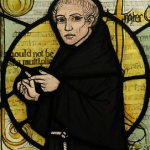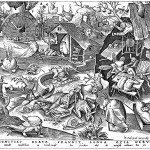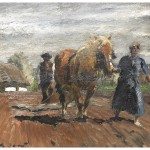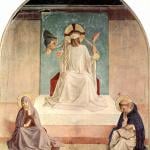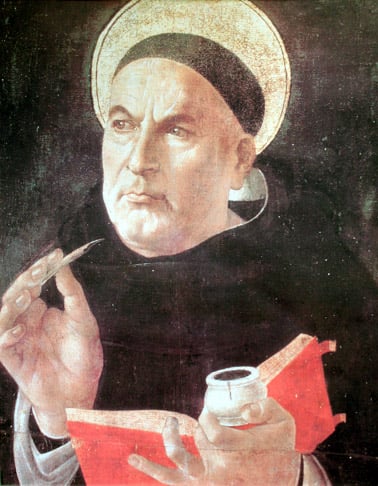
Thomas von Aquin – Sandro Botticelli – Public Domain
It’s been a while since my last post in my ongoing exploration of acedia, which has been guided predominantly by Jean-Charles Nault’s The Noonday Devil: Acedia, The Unnamed Evil of Our Times. That’s partially due to a more hectic than usual work schedule, but predominantly it’s because I’ve been reading Saint Thomas Aquinas’ take on acedia. Pre-study, my knowledge of Saint Thomas (how Nault refers to him, and so how I will) was just a notch above a Wikipedia entry. Most of what I knew of him came through contemporary people who are either formally Neo-Thomists or let his thoughts heavily influence their work – people like Alasdaire Macintyre, Étienne Gilson, and Edward Feser. And so if I wanted to have even a basic understanding of Saint Thomas’ thoughts on acedia, I had to have a better understanding of some of his larger concepts – the goal of scholasticism generally and of Saint Thomas particularly being of course a grand synthesis of theology, logic, and, as I was surprised to discover, a sort of complex psychological rendering of human desire. I couldn’t approach the thing in as piecemeal a manner as I did with the sayings of the desert fathers. And that took time.
Or, I should say, is still taking time. What follows is a basic summary and my initial reactions to Saint Thomas’ writing on acedia, which necessarily includes a description of his cycle of human love. I’m going to get things wrong, certainly. My sincerest apologies upfront for that. Please don’t let my own failures reflect on the skill of my guide, Nault – they’re mine and mine alone.
Nault tells us that Saint Thomas gives two definitions of acedia: sadness about spiritual good (tristitia de bono divino) and disgust with activity (taedium operandi). In this post I’m just going to be concentrating on the first part of the first definition. Saint Thomas is just too complicated a thinker to summarize in a single or even two posts.
In equating acedia with sadness, Saint Thomas leans heavily on the tradition that runs through Saint Gregory. But in drawing deeply from that lineage, he also moves it forward dramatically by calling acedia “the first sin against the joy that springs from charity”, as Nault writes – a sin against gaudium de caritate. Something that becomes immediately apparent when reading Saint Thomas is that his definitions are, not necessarily legalistic, but incredibly technical. They serve a function within the larger system. They’re not atomized. And so when Saint Thomas classifies spiritual sadness as a kind of passion, he means something super specific: a feeling lodged within an act that has a relationship towards good (or evil). It’s important to note here how far we’ve come from the stoicism of the desert fathers, to whom the word “passion” meant something more like it does in our own conventions, something like an involuntary act. This isn’t what Saint Thomas means by it at all. Instead, passion seems, to my mind, more like an orientation towards a final end. Or as Nault elegantly puts it: “For Saint Thomas…a passion is that interior dynamism which enables us to act, which as such is neither good nor bad, but becomes good or bad according to the object it regards and the orientation it takes.”
The most beautiful aspect of this definition, and something that filled me with joy as I studied was that Saint Thomas is adamant about reason’s ability to move through passion, to work within it and shape it. That freedom, the freedom of the rational, paired with Saint Thomas’ idea that love is the foundation of all passions (“every agent, whatever it be, does every action from love of some kind” Saint Thomas writes in question 28 of the Prima secundae) sort of gives us a rough sketch of how human passion operates.
Saint Thomas explicitly maps out the movement of love as passion, as desire, in a cycle (pardon a neophyte, but the circle is an important and reoccurring shape in much theology, no?) of three steps. Nault lists them as:
- The affective union or intentional union
- The desire
- The real union or joy
OK, so by way of example, say you see something that you really want to purchase. Let’s say that it’s a car for sale that you pass during an evening walk. You didn’t expect it, or go out in search of it, it just crossed your path. But the moment you see it and desire it is the first step, the affective union. Saint Thomas subdivides that into three steps: (1) The change: open and passive, your walk leads you to the car (2) adoption: the car touches you, influences you, and actually adapts YOU to itself (3) complaisance: the joy of desire, of an imagined union with the car.
The second movement, the desire, is what moves us from passivity to action. This is when you take down the phone number of the seller or begin pricing your current car for sale. The important thing to note here, Nault tells us, is that the love preceded the desire. The final movement, the action, is buying the car. It’s the attainment of the object of desire.
Love is the root of all action. And the joy (gaudium) which springs from desire is different to the more corporeal pleasure (delectatio). It’s a spiritual happiness.
The next post will concern how Saint Thomas’ definition of friendship relates to joy, and how acedia is a sorrow instead of joy towards the charity of friendship. Again, it’s all about definitions and orientations here. Complicated, perhaps, but spiritually invigorating, and much much warmer than the caricature of scholastic thought that often gets rendered.



